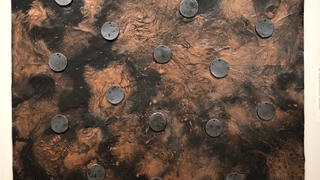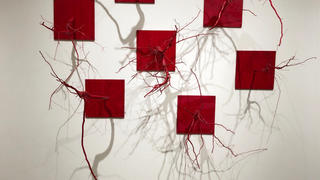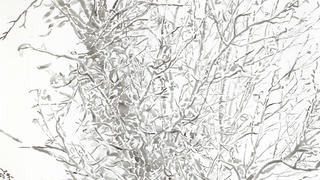Shifting Ecologies: Contemporary Artists and the Environment
Introduction
Shifting Ecologies brings together 15 artists whose work engages with the natural environment. Photographs, drawings, paintings, and three-dimensional pieces made of materials ranging from clay and steel to recycled bottles celebrate the Earth’s beauty and abundance. They also highlight its fragility and prompt action on issues related to pollution, preservation, ownership, and access as the environment and our relationships with it continue to shift. These concerns resonate as well with the Maguire Art Museum, which is situated on the ancestral land of the Lenape Nation. The artists provided statements discussing their artworks and the intentions behind their work. The exhibition is co-curated by Jeanne Bracy, Emily Hage, and Steve Rossi, with curatorial contributions from Jeanne Brasile, Martha Easton, and Krista Svalbonas.
Bebonkwe Brown
Bebonkwe / Jude Norris is a multidisciplinary Plains Cree/Anishnawbe/Metis artist from Amiskwacîwâskahikan (Edmonton, Alberta), based in Brooklyn, NY. Bebonkwe has been making trailblazing work in a variety of media for more than 35 years. Her artworks extend the fem-centric abstraction and adornment practices of Plains Nations, continuing the long matriarchal artistic histories of Turtle Island (aka the Americas) in innovative contemporary ways. She juxtaposes elements of Native material, language, technology, art practice, and iconography with/in Western ones to create dynamic, signature combinations of traditional and new-tech, organic and digital. Bebonkwe’s creative practice embodies the resilient, sustainable and transformative nature of First Nations culture/s, particularly in the navigation of the deep damages to Native peoples and their traditional territories resulting from colonial histories, and their entanglement with ecocrisis.
In keeping with her overall practice, her works in the Maguire Art Museum exhibition exemplify the centering of relationship with the land that is inherent to Indigeneity. Bebonkwe employs a reciprocal, prayerful approach to her variety of materials and creative process, incorporating 'wahkohtowin' cultural gathering practices and collaborations with plant, animal, mineral and ancestor relatives within both urban and bush locations, acknowledging that all are gifts of the Earth and Spirit World, and all are entwined.


Emily Brown
The poet, Emily Dickinson, and the painter, Emily Brown, share an intimate love of nature–both in mood and specificity. Especially in these trying times, Brown’s quiet landscapes, like Dickinson’s poems, elicit feelings of peace and quietude, simultaneous introspection and outward looking, deep breaths and sighs of relief. There is a natural harmony in Brown’s view of the woods where each of the tangled branches contributes to the choir. Her nimble brushwork produces a symphony of leaves, conveys the individual voices of the bare limbs, the bass-line in a darker ripple of water, and the trill of the sky briefly glimpsed in the spare passages of paper. Complex brushwork weaves together notes on the natural world within the flatness of the picture’s planar surface.
From an essay by Susan Danly
Natural cycles expressed through images of change remain at the heart of Brown’s work. The works on display are from Brown’s on-going series of large sumi ink drawings on paper: large, close-up views of forests, water surfaces and views of the ground that envelop the viewer in a myriad of detail.

